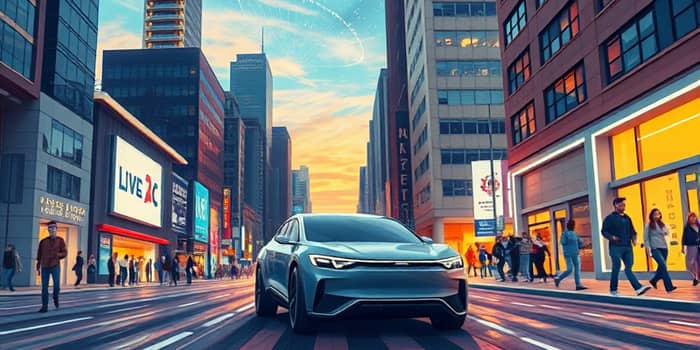
The rise of autonomous vehicles represents more than just a technological shift—it is a catalyst for a profound transformation in how we live, work, and move. Investors and innovators stand on the brink of an era where cars drive themselves, cities reshape their infrastructure, and a new industrial ecosystem emerges. This article explores the market dynamics, key drivers, major players, risks, and opportunities that define the driverless revolution.
The autonomous vehicles market is experiencing unprecedented market growth, with current valuations ranging from $87.23 billion to $208 billion in 2024. By 2025, projections span $273.75 billion to $428.3 billion. Looking further ahead, estimates climb to $1.5 trillion by 2029 and as high as $4.45 trillion by 2034, signaling a paradigm shift in global transportation.
These figures underscore a compound annual growth rate of 31% from 2025 to 2033, reaching historical peaks near 41% in earlier phases. This surge is driven by accelerating innovation in artificial intelligence and sensor technologies.
Several factors converge to propel the autonomous vehicles sector forward:
The race to commercialize driverless cars features a dynamic mix of established automakers, tech giants, and disruptive startups. Major automotive names like Mercedes-Benz, General Motors, Toyota, and Volkswagen are forging alliances with technology leaders such as Tesla, Waymo, NVIDIA, and Uber. At the same time, a new wave of specialized firms in computer vision, battery technology, and connectivity is emerging with fresh capital and agility.
Collaborations and mergers between traditional and digital-first companies are reshaping the competitive map. These alliances not only pool resources but also accelerate research and bring advanced prototypes to market faster than ever before.
According to SAE International, automation is classified from Level 0 (no automation) to Level 5 (full automation). Today, Level 3 vehicles capable of conditional self-driving are rolling off production lines. The ultimate goal remains Level 5, featuring vehicles that operate under all conditions without human input.
Investments are heavily weighted toward bridging the gap from Level 3 to Level 5, with the largest R&D budgets allocated to sensor refinement and fail-safe architectures.
Autonomous vehicles promise to disrupt multiple sectors beyond private cars. The most compelling use cases include:
These applications unlock new revenue streams and business models, from subscription services to dynamic routing platforms.
Beyond the vehicles themselves, a robust ecosystem of complementary technologies is essential. These include advanced routing algorithms, high-capacity edge computing, 5G connectivity, and smart traffic management systems. Cities must also adapt, integrating dedicated AV lanes, reconfiguring parking facilities, and upgrading power grids to support rapid charging.
Investments in digital twins, cyber-physical systems, and Internet of Things networks are powering real-time decision-making, ensuring that each autonomous vehicle operates with precision and security.
North America remains the leader in AV deployment, driven by a supportive regulatory environment and deep pockets of venture capital. The U.S. market alone is valued at $78.96 billion in 2024, expected to skyrocket to $1.8 trillion by 2034 at a 37.1% CAGR. Meanwhile, China, Europe, and other Asia-Pacific economies are rapidly scaling pilot programs, backed by urbanization trends and major government initiatives.
Historical investments in autonomous driving technologies reached $80 billion by 2017. Since then, funding has accelerated, with global R&D budgets and venture capital deals climbing year after year. Investors eye not only pure-play AV companies but also startups specializing in critical subsystems like battery innovations and cybersecurity.
Strategic acquisitions and alliances continue to reshape the investment landscape. Traditional automakers are forming joint ventures with software firms, while tech companies are acquiring niche players to secure intellectual property and talent.
Despite the promise, several challenges loom:
Autonomous vehicles offer the potential to reduce traffic fatalities by up to 94%, as human error currently accounts for the vast majority of accidents. Improved traffic efficiency can also cut congestion and emissions, making urban living more sustainable. Moreover, AVs hold the promise of greater inclusivity, providing mobility solutions for the elderly and disabled.
By reimagining parking spaces and road usage, cities can reclaim land for green spaces and pedestrian zones, fostering healthier and more connected communities.
Between 2025 and 2035, the AV sector is poised for a major disruption phase. Commercial fleets of robotaxis, autonomous delivery vehicles, and public transport shuttles will begin permuting every aspect of transportation and logistics. Market consolidation will accelerate as automotive giants and tech leaders fight for dominance through mergers, acquisitions, and strategic partnerships.
For investors, the driverless revolution presents both immense opportunity and significant risk. A balanced portfolio that includes core AV innovators, supporting technology providers, and infrastructure projects can capture the upside of this transformation while mitigating exposure to regulatory and technical hurdles.
As we steer into this new frontier, the fusion of human ingenuity, cutting-edge technology, and bold investment will determine how swiftly and smoothly autonomous vehicles reshape our world.
References













